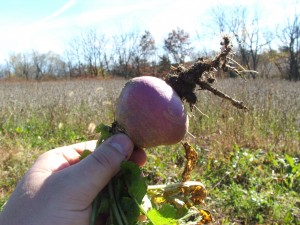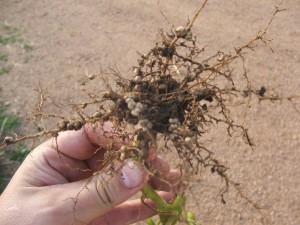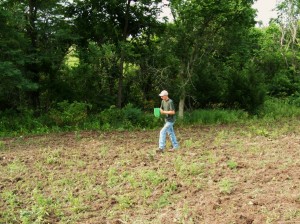Whitetail 365 July-The Dog Days of Summer
Introduction– There is honestly very few things that get me excited about managing my farm in July. Spring planting of food plots and spraying has been completed. Stands are already hung for the most part. Everything is growing in the deer’s realm including fawns and antlers. These are the lazy days of summer. The dog days! Average temperatures are in the mid-eighties throughout the mid-west. Remember 2012 and 13…I do. Many days of super-hot 90’s and 100’s. These are not great days or fun days to be out on our properties trying to improve them. For the most part really, I actually dis-like summer. Hot and humid the saying goes right? Each year I look forward to spring as an exciting time of year on my farm…but then try to wish away mid-summer in anticipation for fall. For 2015, I have really tried to purposely focus on laying out a food plot and habitat plan for any hunter in these Whitetails 365 articles. Like it or not, there is a very important July planting that needs to take place. Brassicas!
Summer Planted Brassicas -Brassicas are not a new phenomenon. They have been around almost forever and include everything from turnips to broccoli to cabbage. Farmers have used different varieties of brassicas as forage in grazing systems long before any hunter planted them to attract deer. As hunters, it is in our best interest to find and plant varieties that deer like to eat while the plant is green and growing. It is also important to find varieties that produce bulbs for a late season food source after most or all other green plants have frozen and died. Many brassica varieties are also quite frost resistant and can remain green after a killing frost.
July planted brassicas are all about root or bulb production for me. Fall green food plots are planted with the goal of having preferred green forage available as far into the season as we can. But summer planted brassicas are all about root production. I say this because there are other more preferred plots that you can plant for a green food plot. However, long after green food plots have perished to freezing temperatures and your soybean and corn plots are exhausted, the bulbs of brassicas will still remain as a winter food source for the deer herd. To get maximum root development with your brassicas they need to be planted in mid-summer.
Varieties-Food plot seed manufacturers and their marketing companies will have you believe that each has its own unique and special blend of seeds. While technically this may be true, planting brassicas is not a big trade secret. Some seed marketed for food plots is actually very well put together in blends making for easy decisions by the hunter. Others I have found have simply jumped onto the food plot band wagon. I bring this up only to emphasize that when it comes to food plot seed…buyer beware! It’s because of this reason I mostly buy and plant seed I’ve purchased in bulk from an Ag or wholesale seed supplier. I can pick out the varieties I want and pay a fraction of the cost of store bought name brand seed.
There are two types per say of brassicas you can plant for deer food plots. Forage brassicas are varieties that are bread for leaf production. They put on a ton of forage but sometimes depending on the variety have very little root or bulb. Non-forage brassicas are grown for bulb production. It is these non-forage brassicas that I target for summer plantings. My goal is to produce a crop that will withstand summer and fall grazing but will remain well into winter when the other more preferred food sources have been depleted. This can be accomplished with many varieties of brassicas…but my favorite has to be purple top turnips. I like purple tops because they are fairly easy to grow, the seeds are cheap, and they produce massive bulbs.

When summer planting brassicas, I like bulb producing brassicas like this purple top turnip.
There are other varieties that work well also like Barkant and Barsica turnips…but they are generally harder to find and they also produce more forage than bulb. If you are working with a seed supplier, co-op, or other bulk seed provider they can surely help you with finding a good turnip seed with good bulb production. If you prefer to buy a name brand food plot blend, I would suggest writing down the seed varieties off the package and doing a Google search on each variety to make sure you have a good percentage of bulb or root producing seeds.
Soybeans and Turnips-Turnips require a fair amount of nitrogen to make them grow and put on forage leafy mass or bulbs. Nitrogen is also fairly expensive. A summer planting of turnips also carries with it a higher risk of weed competition. What does this have to do with soybeans? Well…by planting all of my exterior plots in soybeans in the spring and spraying them with glyphosate (for roundup ready varieties) I have accomplished two very important things. I have done a great job at weed control in these plots and the soybean plants have been fixing nitrogen since shortly after they emerged from the ground. By tilling under select areas of soybeans and replanting with brassicas I will have a great weed free seed bed full of rotting soybean mass full of nitrogen! Soybeans fix or create somewhere near 60% or so if the nitrogen required for the plant and bean. This can mean as much as 120lbs/acre of nitrogen is made by the plant through a process called fixation. As the plant dies and rots (because we tilled it under) this nitrogen becomes available for the next plants.

By mid-July, soybeans have already fixed a large portion of the nitrogen they are going to fix during the growing season. Tilling under beans at this stage can get you up to the equivalent of 60lbs/acre nitrogen. These nodules on the soybean root (small white balls) are actually colonies of bacteria where this magic takes place.
Because we are tilling under the soybeans before they are mature, agronomists tell me we can expect as much as half that amount of nitrogen. Perfect! Brassicas need about 60lbs/acre of nitrogen to be good strong plants. By tilling under soybeans we have created a scenario where there are very few if any weeds and we have provided all the nitrogen we need for a good turnip plot.
Planting-By mid-July of each year, I will select the areas I want to plant my bulb producing brassicas. I usually pick the edges of my soybean plots or areas that hold moisture a little better. Edges of fields that have late afternoon shade seem to be good spots as well. Turnips like cooler and moist soils so I will target these areas if I have them. If indeed soybeans are present and I want to convert some or the entire soybean plot, I will till in the beans with my disc working them back into the soil. On ground that hasn’t yet been planted, create a seed bed by working the ground several times or by spraying with glyphosate a few weeks before planting…or better yet both. If planting in a soybean tilled seed bed, no fertilizer should be required. If planting in new ground, apply and work in about 60lbs/acre of nitrogen.

One of the best and most efficient way to broadcast small seed like brassicas is seeding with a small hand seeder.
Brassica seed is small, so a hand seeder sometimes works the best in spreading out the seed. I use about 5lbs/acre of turnip seed and plan on planting the seed only 1/4 inch deep. I can accomplish this by spreading the seed and then pulling a drag or packer of some sort over the seed bed. For me this has been a tine drag, bed spring, pallet, or driving over the plot with by 4 wheeler. Personally, I like to drag in the brassica seed with a tine drag. It seems to get the seed just in the ground and does an adequate job of packing the seed. If possible, till and plant right before rain. This will ensure adequate moisture for germination and will dissolve any nitrogen fertilizer you put down.
In Conclusion-Summer planted brassicas are an important part of an overall food plot strategy. The bulbs produced by the brassicas will last well into the winter giving your farm or hunting grounds a good food source well after many others are gone. By focusing on bulb producing turnips like Purple Tops or targeting food plot blends with bulb producing varieties in them we make sure to get the right seed in the ground. Planting turnips in tilled under soybean plots eliminates or greatly reduces our need to add extra nitrogen. July is the dog days of summer. Other than shooting my bow and glassing for bucks there is really not a heck of a lot to do when preparing for this fall.
This year in July, I will be discing under some of my spring planted soybeans and seeding in bulb producing turnips like purple tops. I will also be mowing my perennial clover and alfalfa plots to clip off any high plants that have not been browsed off. Late July is also a good time to fertilize these perennial plots so I plan to fertilize my clover and alfalfa with a 4-12-42 high potash fertilizer around the end of July.
In the August segment of Whitetails 365, I will be covering fall planted annual green food plots with an emphasis and discussion on why I like to plant winter rye in the fall over other winter hardy varieties.
